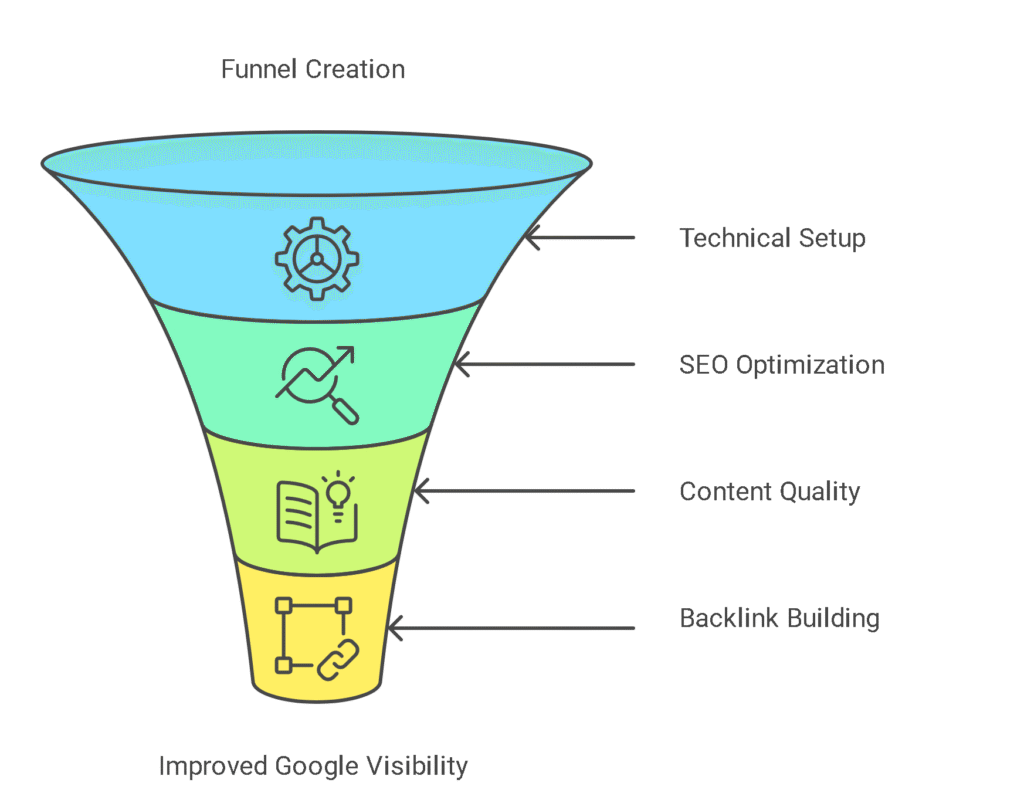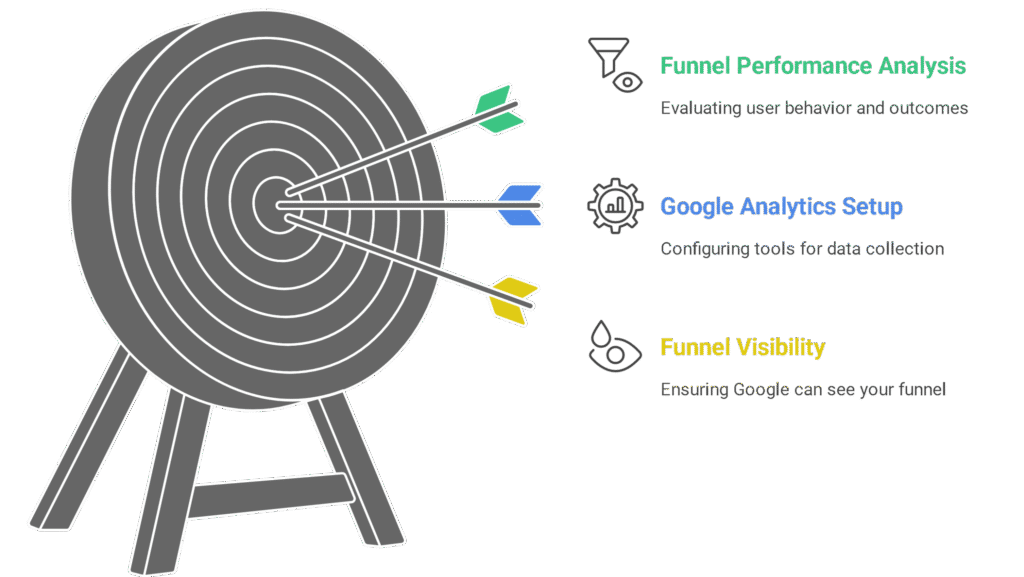How to Make GoHighLevel Funnel Show on Google? 11 Pro Strategies
If you have built a funnel using GoHighLevel and now want it to show on Google, you are not alone. Many people create stunning funnels but later struggle with getting them visible to the right audience.
The good news is that getting your GoHighLevel funnel to show on Google is absolutely doable. It just needs some patience and understanding of how Google sees your content.
In this guide, you will learn how to make your funnel appear in Google search results. You will also find helpful tips to improve your chances of ranking higher.
Key Takeaways
If you want a funnel that not only looks good but is built to be found, check out these professionally tested templates. Designed with search visibility in mind and to keep your prospects moving.
Read this: How to Forward GoHighLevel Funnel: Full-Length Guide
Why is Your GoHighLevel Funnel Not Showing on Google?
Before we move to the solution, it is important to understand the problem. Here are the key reasons why your GoHighLevel funnel is not showing up on Google:

How to Make A GoHighLevel Funnel Show on Google?
When you create a funnel inside GoHighLevel, it does not automatically show up on Google. That is because search engines like Google need to find your page, understand it, and then decide where to rank it.
Here are some helpful strategies to show your GoHighLevel funnel on Google:
Set a Custom Domain for Your Funnel
When you first create a funnel on GoHighLevel, it gives you a default URL. This is usually something like yoursubdomain.gohighlevel.com. This link works, but it is not the best for SEO.
Google prefers content that comes from custom domains. If you want Google to take your funnel seriously, then connect it to your own domain.
Use a branded domain like www.yourbrand.com or a subdomain like offers.yourbrand.com. This gives you more control and trust from search engines.
Inside GoHighLevel, go to Settings. Then click on Domains. Add your domain there and connect it with your funnel.
Make Sure Your Funnel Is Indexable
Just creating a funnel is not enough. You need to make sure Google can actually read and index your pages. If the page is blocked, Google cannot see it.
Inside your funnel settings, look for the SEO Meta Data tab. Check if the No Index option is turned off. If it is turned on, Google will not include that page in search results.
Make sure each step of your funnel is open for indexing. Also, avoid hiding content using scripts. Google bots cannot always read that hidden content.
Add Meta Titles and Meta Descriptions
Google uses your page title and description to understand what it is about. These details are shown in the search results, so they matter a lot.
Inside your funnel settings, go to each step of your funnel. Open the SEO tab and write a unique title and description. Use clear keywords that people might type into Google when looking for your service or product.
Do this for each page. It improves your chances of showing up when someone searches for your service.
Read this: Import Clickfunnels to GoHighLevel: Detailed Guide for 2025
Add Quality Content on Funnel Pages
Google loves content. If your funnel only has a headline and a button, it might not be enough. You need to give your visitors helpful and meaningful content.
Add a short intro, a list of benefits, and answers to common questions. Write it in simple words so both visitors and search engines can understand it. Use headings to break it down.
Also, make sure your content is not copied from somewhere else. Google checks for duplicate content. Always use original text and make it useful for your reader.
The more value you add, the better your funnel will perform in search results.
Not sure how to structure your funnel or what to write? A well-designed funnel template can guide you with the right sections already placed to keep visitors engaged and lead them toward action. Explore them here.
Connect Your Funnel to Google Search Console
Now that your funnel is ready, tell Google about it. The best way to do this is through Google Search Console. It is a free tool that lets you submit your pages to Google.
Go to search.google.com/search-console and add your domain. Follow the steps to verify it.
Once done, go to the URL Inspection tool inside Search Console. Enter the full link of your funnel page and click on Request Indexing.
This is like telling Google, Hey, I have a new page. Please check it.
It can take a few hours or a few days for Google to index your page. Be patient and keep checking the status.
Create a Sitemap
A sitemap is a file that lists all the pages of your site. It helps Google find your content faster.
GoHighLevel does not create a sitemap automatically for your funnel. But you can build one manually or use third-party tools. Once created, you can submit it in your Google Search Console account.
This step is not required but highly recommended if you have multiple funnel pages.
Use Simple URLs and Keywords
Your funnel page URLs should be easy to read and contain your keywords. Avoid using random numbers or long strings. You can edit the path for each funnel step inside the page settings in GoHighLevel.
Add Backlinks to Your Funnel
Backlinks are links from other websites that point to your funnel. Google sees them as a sign of trust. The more quality backlinks you have, the better your chances of ranking.
You can get backlinks by sharing your funnel on social media, adding it to your blog, or writing guest posts for other websites.
Make It Mobile Friendly
GoHighLevel funnels are usually mobile friendly by default. But it is still good to test them on different screen sizes. Make sure the text is easy to read, the buttons are clickable, and the page loads fast.
You can check mobile performance in Google Search Console or use tools like Google Mobile Friendly Test.
Improve Loading Speed
If your funnel takes too long to load, it might not rank well. So keep your funnel pages light.
Avoid heavy animations. Compress images before uploading. You can also use tools like PageSpeed Insights to test your funnel and get suggestions.
Keep Updating Your Funnel
Google rewards fresh and active content. Do not just build a funnel and forget it.
Update your text. Add new offers. Change images once in a while. Add customer reviews or testimonials. Every small update tells Google that your page is still alive and relevant.
Tracking Your Funnel Performance on Google
After making your funnel visible to Google, you need to track how it performs. This is where Google Analytics becomes very helpful.
Just like Google Search Console shows you how your page ranks, Google Analytics shows you what users do once they land on your funnel. Here is how to set this up:

This is powerful because it tells you what is working and what needs to change. If people are leaving on the first step, you might need a better headline. If no one is clicking the call-to-action, maybe the button is not clear enough.
Bonus Tip: Use Google My Business for Local Funnels
If your business serves a local area like a city or neighborhood, setting up Google My Business (now called Google Business Profile) can make a big difference.
It helps your business show up on Google Maps and local search. You can add your funnel link directly to your business profile. That way, when someone searches for services in your area, they can find your funnel faster.
To do this, go to Google Business Profile, claim your business, and fill out your details. Add your funnel link in the website field or as part of your service descriptions.
Bottom Line
Getting your GoHighLevel funnel to show on Google is not about tricks. It is about clarity, consistency, and smart execution.
And if you want to skip guesswork, you can start with a custom funnel template that is built with Google in mind. Visibility is not a mystery. It is a method.








